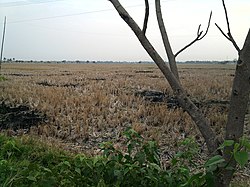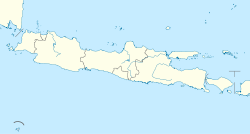Historical
Pontang port and the Ciujung river used to be important for carrying merchandise into the interior. Tomé Pires, who wrote of the region around 1515, said Pontang was one of the busy and crowded ports of the Sunda kingdom. The harbor was smaller than that of Banten, but the only one where large ships could anchor. The city was beautiful, with the harbor at the river bank near the sea shore. Rice, pepper and food were sold. To guard against Muslim influence the king banned trade with Muslim merchants from Java.
By the end of the 17th century the "sultan's canals" had been built for the purpose of irrigation between Markasana and Kanari, and between Pontang, Tanara and Bensung. Presumably some rice fields were irrigated in the mid-18th century. However, until the 20th century sawah that depended on rain covered 2.5 times more land than irrigated sawah in the coastal region.
In 1813 Java was under British control and the land was being leased rather than subject to forced deliveries and contingents as it had been under the Dutch. Major Udney Yule, the British resident, was instructed by Stamford Raffles to grant equitable and moderate leases to the renter class. All the half-yearly rents in the Bantam Residency due on 1 July 1813 were paid on time apart from those due from Pontang, Tanara, Tambakbaya and Trate(?). In this area a drought had caused the rice crop to fail entirely.

Java is an island of Indonesia, bordered by the Indian Ocean on the south and the Java Sea on the north. With a population of over 141 million or 145 million, Java constitutes 56.7 percent of the Indonesian population and is the world's most-populous island. The Indonesian capital city, Jakarta, is on its northwestern coast. Much of the well-known part of Indonesian history took place on Java. It was the centre of powerful Hindu-Buddhist empires, the Islamic sultanates, and the core of the colonial Dutch East Indies. Java was also the center of the Indonesian struggle for independence during the 1930s and 1940s. Java dominates Indonesia politically, economically and culturally. Four of Indonesia's eight UNESCO world heritage sites are located in Java: Ujung Kulon National Park, Borobudur Temple, Prambanan Temple, and Sangiran Early Man Site.

Banten is the westernmost province on the island of Java, in Indonesia. Its provincial capital city is Serang. The province borders West Java and the Special Capital Region of Jakarta to the east, the Java Sea to the north, the Indian Ocean to the south, and the Sunda Strait to the west, which separates Java from the neighbouring island of Sumatra. The population of Banten was officially estimated at 13,160,496 in the middle of 2020, up from over 10.6 million during the 2010 census. Formerly part of the province of West Java, Banten became a separate province in 2000. The province is a transit corridor to the neighbouring Indonesian island of Sumatra. The Banten region is the homeland of the Bantenese people and has historically had a slightly different culture from the Sundanese people in the West Java region. In recent years, the northern half, particularly those areas near Jakarta and the Java Sea coast, have experienced rapid rises in population and urbanization, while the southern half, particularly that facing the Indian Ocean, maintains a more traditional character.
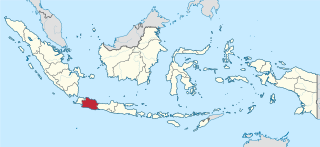
West Java is a province of Indonesia on the western part of the island of Java, with its provincial capital in Bandung. West Java is bordered by the province of Banten and the country's capital region of Jakarta to the west, the Java Sea to the north, the province of Central Java to the east and the Indian Ocean to the south. The province is the native homeland of the Sundanese people, the second-largest ethnic group in Indonesia after the Javanese.

Central Java is a province of Indonesia, located in the middle of the island of Java. Its administrative capital is Semarang. It is bordered by West Java in the west, the Indian Ocean and the Special Region of Yogyakarta in the south, East Java in the east, and the Java Sea in the north. It has a total area of 32,548 km², with a population of 34,552,500 in mid 2019, making it the third-most populous province in both Java and Indonesia after West Java and East Java. The province also includes the island of Nusakambangan in the south, and the Karimun Jawa Islands in the Java Sea. Central Java is also a cultural concept that includes the Special Region and city of Yogyakarta. However, administratively the city and its surrounding regencies have formed a separate special region since the country's independence, and is administrated separately. Although known as the "heart" of Javanese culture, there are several other non-Javanese ethnic groups, such as the Sundanese on the border with West Java. Chinese Indonesians, Arab Indonesians, and Indian Indonesians are also scattered throughout the province.

The angklung is a musical instrument from West Java, Indonesia made of a varying number of bamboo tubes attached to a bamboo frame. The tubes are carved to have a resonant pitch when struck and are tuned to octaves, similar to Western handbells. The base of the frame is held in one hand, while the other hand shakes the instrument, causing a repeating note to sound. Each performer in an angklung ensemble is typically responsible for just one pitch, sounding their individual angklung at the appropriate times to produce complete melodies . The angklung is popular throughout the world, but it originated in what is now West Java and Banten provinces in Indonesia, and has been played by the Sundanese for many centuries. The angklung and its music have become an important part of the cultural identity of Sundanese communities in West Java and Banten. Playing the angklung as an orchestra requires cooperation and coordination, and is believed to promote the values of teamwork, mutual respect and social harmony.

The Baduy are a traditional Bantenese community living in the southeastern part of the Indonesian province of Banten, near Rangkasbitung. Ethnically the Baduys belong to the Sundanese ethnic group, they are considered an uncontacted people, a group who are almost completely isolated from the outside world.
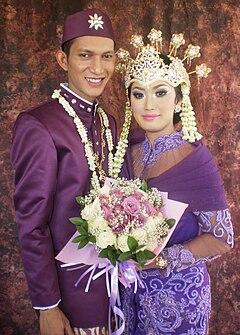
The Sundanese are an Austronesian ethnic group native to the western part of the island of Java in Indonesia. They number approximately 40 million and form Indonesia's second most populous ethnic group, after the neighbouring Javanese. In their language, Sundanese, the Sundanese refer to themselves as Urang Sunda, while Orang Sunda or Suku Sunda is its Indonesian equivalent.

The Banten Sultanate was an Islamic trading kingdom founded in the 16th century and centred in Banten, a port city on the northwest coast of Java; the contemporary English name of both was Bantam. It is said to have been founded by Sunan Gunungjati, who had previously founded Cirebon.

Rice production in Indonesia is an important part of the national economy. Indonesia is the third-largest producer of rice in the world.

Ci Durian, or Ci Kandi, is a river in the Banten province of western Java, Indonesia. It rises in the mountains to the south and flows north to the Java Sea. The delta of the river, now canalized, has long been used for rice paddies and for a period was also used for sugarcane plantations. Extensive irrigation works diverted water from the river into a canal system in the 1920s, but these works were not completed and suffered from neglect in the post-colonial era. Plans were made in the 1990s to rehabilitate the irrigation works and dam the river to provide water for industrial projects, with Dutch and Japanese assistance, but these were cancelled by the Indonesian government.

The Cisadane River is a 138 kilometres (86 mi) long river in northern West Java, Indonesia. The river has its source at Mount Pangrango, and passes through Bogor and Tangerang before flowing to the Java Sea.
The Buni culture is a prehistoric clay pottery culture that flourished in coastal northern West Java, Jakarta and Banten around 400 BC to 100 AD and probably survived until 500 AD. The culture was named after its first discovered archaeological site, Buni village in Babelan, Bekasi, east of Jakarta.
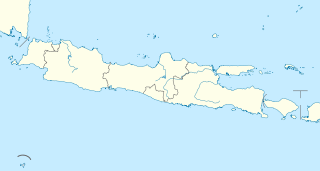
Tanara is a district in the Banten province on the island of Java, Indonesia.

The Ci Banten, or Ci Peteh, is a river in Banten province on the island of Java, Indonesia.
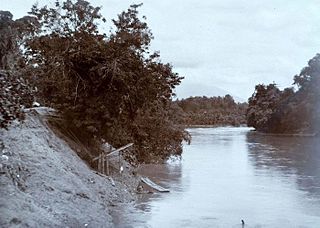
The Ciujung is a river in the province of West Java and Banten on the island of Java, Indonesia.

Tambakbaya is a village in the Banten province on the island of Java, Indonesia.

Ci Manceuri, or Cimanceuri, is a river in the Banten province of western Java, Indonesia.
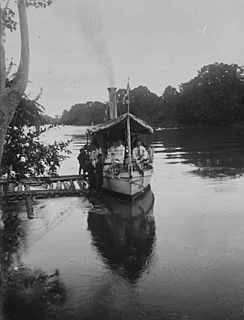
Tulang Bawang River is a river which mostly flows in Lampung, Indonesia. The river lends its name to the Tulang Bawang Regency, where it reaches the Java Sea and the West Tulang Bawang Regency. It also flows across the capital of the regency at Menggala.
Mahmud Badaruddin I, also known as Jayo Wikramo, was the fourth regent of the Palembang Sultanate in Palembang, South Sumatra. Mahmud Badaruddin I reigned the Palembang Sultanate between 1724 and 1757.

Abuya Kyai Hajji Ahmad Muhtadi bin Dimyathi al-Bantani or better known as Abuya Muhtadi is an influential Indonesian Muslim cleric from Banten. He is known as one of the Muslim scholars close to President Joko Widodo. At the Zikir Kebangsaan which was first held by the Indonesian government in the Merdeka Palace in 2017, Muhtadi was one of the religious leaders invited by the president. In the 2019 Indonesian presidential election, he supported a friend who was also a Muslim cleric from Banten, Ma'ruf Amin, who became the running mate of incumbent presidential candidate, Joko Widodo. Even so, in the 2014 Indonesian presidential election, he supported Prabowo Subianto as a candidate for Indonesian President and instructed his students to vote for Subianto.
